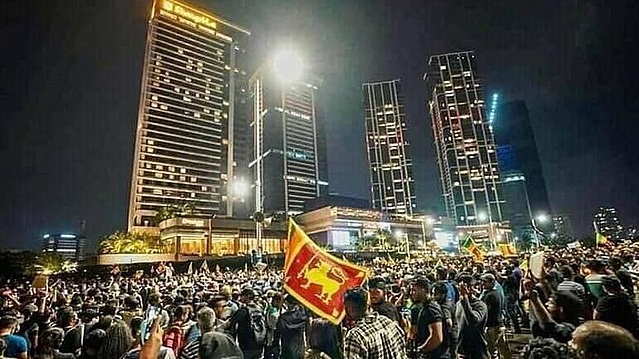After weeks of mass protests and two no-confidence motions in the parliament, Sri Lankan prime minister Mahinda Rajapaksa resigned on Monday, May 9. Throughout the day, incidents of violence broke out across the island nation following provocations by pro-government protesters. At least three people are reported to have been killed outside the capital while over 150 people were injured in the capital Colombo alone, according to media reports. In the aftermath of the incidents, massive crowds gathered in the capital’s Galle Face against the government’s policies despite a curfew being declared.
On Monday morning, supporters of Rajapaksa and his brother president Gotabaya Rajapaksa attacked anti-government protesters. The pro-government mob reportedly tore up tents at a protest site in Colombo and attacked and beat up protesters. In the following hours, crowds took to the streets in various parts of the country, attacking senior leaders, members and offices of the ruling party. The ancestral home of the Rajapaksas was set on fire. A member of parliament from the ruling party reportedly shot two protesters and then himself fatally after being surrounded by a furious crowd.
These developments are part of the political churning the island nation is currently experiencing. On May 6, president Gotabaya Rajapaksa yet again imposed a public emergency in the country in the name of “public security and the protection of public order.” This was the second time an emergency has been imposed in Sri Lanka after the first declaration on April 1 which backfired and led to a further escalation of people’s protests.
In early April, the entire cabinet had already resigned except for PM Rajapaksa and a smaller cabinet was formed. On May 4, two no-confidence motions – against president Gotabaya Rajapaksa and against his government – were submitted by the opposition to the speaker of the parliament, Mahinda Yapa Abeywardena by the opposition Samagi Jana Balawegaya.
Sri Lanka has been dealing with an economic crisis for months, characterized by a foreign exchange shortage and a subsequent scarcity of essentials such as food, fuel and medicines. Grappling with near-bankruptcy, Sri Lanka declared a pre-emptive default on its USD 51 million total foreign debt last month. The government’s only solution has been to approach the IMF and other international sources for aid. In the wake of the crisis, massive protests broke out in the country, especially in Colombo, with the slogan ‘Gota Go Home’ resonating across the island. The resignation of PM Rajapaksa alone is unlikely to satisfy protesters who continue to demand that the president give up power as well.





